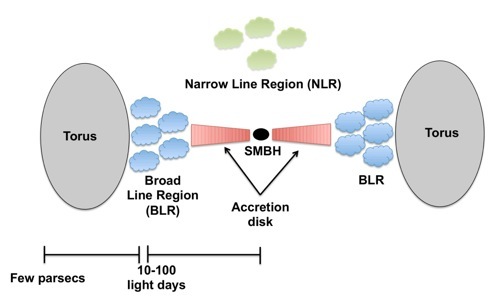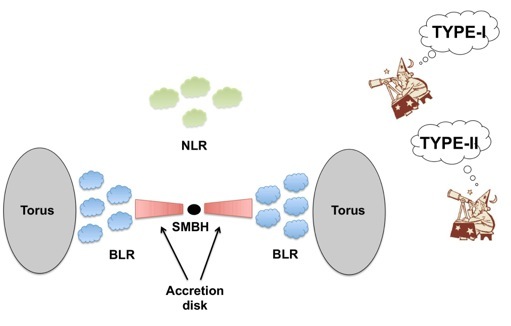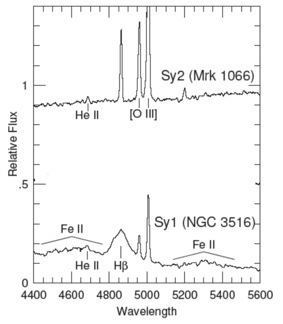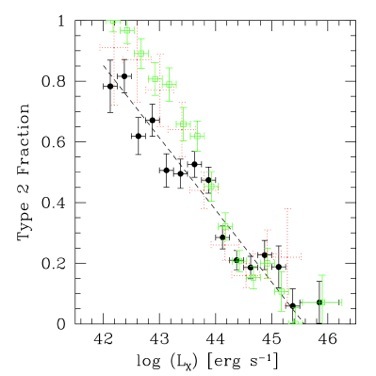







Active Galactic Nuclei (AGN)
Active Galactic Nuclei (AGN) are the most luminous persistent sources of radiation in the Universe, and are powered by accretion onto a supermassive black hole (SMBH). In the last ten years it has become evident that most galaxies have gone through an AGN phase, which has played a crucial role in their formation and evolution.

The typical AGN is made of several components (see Fig. 1 on the right):
-
-An accretion disk where matter is funneled onto the SMBH.
-
-A broad line region (BLR) where the broad and optical/UV lines are produced. Reverberation mapping studies have shown that the inner radius of this region scales with the luminosity and is ~10-100 light days (e.g., Kaspi et al. 2005).
-
-A molecular torus, which is located within few parsecs from the SMBH. Near-IR reverberation studies have shown that the inner radius of the torus also scales with the luminosity (Suganuma et al. 2006).
-
-A narrow line region (NLR), which is located at ~100-300 pc from the SMBH, where the narrow optical lines are created.
A very large number of studies, carried out in the last 10-20 years at different wavelengths, have found evidence of a decrease of the fraction of type-II AGN with the luminosity (see Fig. 4). This effect cannot be easily explained by the simple unification model, and led to the formulation of the luminosity-dependent unification of AGN (e.g. Ueda et al. 2003).
According to this scheme, the covering factor of the torus decreases with the luminosity, so that for high luminosities the chance to observe the AGN edge-on with respect to the torus is low. This effect is probably related to the increase of radiation pressure, which cleans up the environment of AGN.
AGN Structure
Simple unification model of AGN


Luminosity-dependent unification of AGN
Most AGN are radio-quiet, and can be divided into two classes, according to their optical spectra. Type-I AGN, also called Seyfert 1s (Sy1s), show both broad and narrow lines, while type-II AGN (Seyfert 2s or Sy2s) show only narrow lines (see Fig. 2). According to the simple unification model (e.g., Antonucci 1993), these objects are intrinsically the same, but are observed with different inclination angles with respect to the molecular torus (Fig. 3). Type-I are observed pole on, so that it is possible to observe both the BLR and the NLR, while type-II are see edge-on, and the BLR is hidden by the torus.
Fig. 2 Typical optical spectrum of a Sy1 and a Sy2 (adapted from Pogge, 2000)

Fig. 4 Decrease of the type-II fraction with the luminosity (Hasinger 2008)







